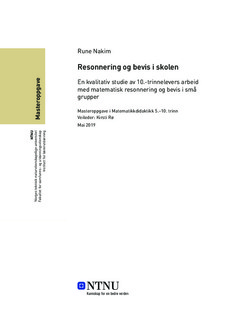| dc.contributor.advisor | Rø, Kirsti | |
| dc.contributor.author | Nakim, Rune | |
| dc.date.accessioned | 2019-08-23T14:07:36Z | |
| dc.date.available | 2019-08-23T14:07:36Z | |
| dc.date.issued | 2019 | |
| dc.identifier.uri | http://hdl.handle.net/11250/2610295 | |
| dc.description.abstract | Denne studien har undersøkt elevers arbeid med å formulere og begrunne hypoteser. Hensikten har vært å få innsikt i elevers arbeid med resonnering og bevis ved avslutning av grunnskolen, som kilde til refleksjon over muligheter og utfordringer med arbeid med resonnering og bevis i skolen. Studiens forskningsspørsmål er: Hva kjennetegner en gruppe 10.-trinnelevers deltakelse i en matematisk diskurs av resonnering og bevis?
Studien har benyttet kvalitative metoder med observasjon av to grupper, hver med tre elever, sitt arbeid med en oppgave om sammenhenger i multiplikasjon. Elevene arbeidet alene uten støtte, og fikk ikke undervisning rettet mot resonnering og bevis i forbindelse med studien. Datamaterialet ble analysert ved hjelp av induktiv analyse med åpen koding, en modell av matematisk resonnering, og et rammeverk for elevers deltagelse i en matematisk diskurs. Det overordnede teoretiske rammeverket tar utgangspunkt i et sosiokulturelt syn på læring som deltagelse, og det er elevenes felles deltagelse i små grupper som er analysert. Studien benyttet en modell som baserer seg på en vid definisjon av resonnering og bevis, som inkluderer et prosessaspekt og et strukturelt aspekt. Resonneringsprosessene er eksemplifisering, sammenligning, identifisering av et mønster, generalisering, formulering av en formodning, klassifisering, begrunnelse, formulering av et bevis og formulering av et formelt bevis. Det strukturelle aspektet inkluderer deduksjon, induksjon og abduksjon.
Studien viser hvordan elever kan delta i arbeid med resonnering og bevis, noe som kan gi grunnlag for refleksjon om undervisningspraksis. Resultatene fra studien viser at elevene deltar i de fleste av resonneringsprosessene, både med formulering av hypoteser, og med begrunnelser og bevis. Studien viser også at elevene bruker eksempler som støtte i alle resonneringsprosessene, både for å formulere og revidere hypoteser, og i formulering av begrunnelser og bevis. Elevene uttrykker usikkerhet om hvordan de skal forklare, og de baserer seg på andres aksept og ikke på kriterier for bevis for å vurdere eget arbeid. Resultatene viser at elevene forsøker å forklare og vise hvorfor en påstand er sann på tre måter: ved gjentatt sammenligning av nye eksempler for å finne mulige sammenhenger, utregning ved hjelp av et numerisk eksempel, og et generisk bevis. Til tross for at elevene ved en anledning formulerer et bevis, indikerer studien at de har liten kjennskap til hvordan de kan forklare eller vise hvorfor en matematisk påstand er sann.
Nøkkelord: matematisk resonnering, bevis, resonnering og bevis, kommognisjon, diskurs, læring som deltagelse. | |
| dc.description.abstract | This study has looked at the participation of students in formulating and justifying hypotheses. The purpose has been to get insight in students’ work with reasoning and proof at the end of their ten years of compulsory education, as a source of reflection on possibilities and challenges with reasoning and proof in school mathematics. The research question is: What characterizes a group of year 10 students’ participation in a mathematical discourse of reasoning and proof?
The study has used qualitative methods with observation of two groups, each with three students, working on a task about relations in multiplication. The students worked alone without support and was not given instruction on reasoning and proof in connection with the study. Data was analyzed using inductive analysis with open coding, a model of mathematical reasoning, and a framework for student participation in a mathematical discourse. The main theoretical framework is based on a sociocultural view of learning as participation, and it is the common participation of students in small groups that have been analyzed. The study used a model based on a wide definition of reasoning and proof, which includes a process aspect and a structural aspect. The reasoning processes are exemplifying, comparing, identifying a pattern, generalizing, conjecturing, classifying, justifying, proving and formal proving. The structural aspect includes deduction, induction and abduction.
The study shows how students can participate in work on reasoning and proof, possibly leading to reflection about instruction practice. The results of the study show that students participate in most of the reasoning processes, both with formulation of hypotheses, and justification and proof. The study also shows that the students use examples as support in all reasoning processes, both in formulation and revision of hypotheses, and in justification and proof. The students express insecurity about how to explain, and they base assessment of their work on the acceptance of other people, not on criteria for proof. Results show that the students try to explain and show why a statement is true in three ways: repeated comparisons of new examples to find possible relations, calculations based on a numerical example, and a generic proof. Even though the students formulate a proof, the study indicates that they have little knowledge of how they can explain or show why a mathematical statement is true.
Keywords: mathematical reasoning, proof, reasoning and proof, commognition, discourse, learning as participation. | |
| dc.language | nob | |
| dc.publisher | NTNU | |
| dc.title | Resonnering og bevis i skolen | |
| dc.type | Master thesis | |
